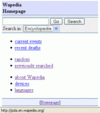Every now and then a ‘brilliant’ analyst claims that UMTS is just too slow and only a couple of users would be enough to fully load a cell. However, they usually never reveal how they come to this conclusion. So let’s set something straight here:
Data Rate
Only a few years ago, a per user bandwidth of 384 kbit/s over the air interface almost seemed like magic. Compared to DSL speeds today, it seems to be rather slow as entry level DSL usually starts at 1000 kbit/s today. For web surfing, the main application of most people today, there is only little difference between page download times of UMTS and DSL. For file downloads, a data rate of 40 kbytes/s can also not be called slow. Here, DSL undoubtedly has an advantage. Voice over IP (over UMTS) software such as Skype also works quite well. And, not to forget, networks are about to be upgraded to HSDPA which increases peak data rates to 2-3 MBit/s per user. Not quite here yet, but coming soon.
Users per Cell
The next myth often spread by analysts is the low number of subscribers that can be served by a cell. It is certainly true that only three users can be assigned a 384 kbit/s bearer simultaneously in order preserve some bandwidth for voice telephony and slower data connections. If all three users would transfer a file simultaneously or stream a video, the cell would be fully loaded. However, not all users of a cell download data at the same time. Apart from “power users”, most subscribers use their Internet connection for web browsing and only seldom for downloading files or streaming audio or video content. This will surely change in the next couple of years, but the network continues to evolve as well with HSDPA and other future enhancements.
Voice over IP systems, such as Skype, will surely be used by more and more people in the future. However, the data rate generated by such applications is around 3 kByte/s in both uplink and downlink direction. This is much less than the 40 kBytes/s offered by UMTS today. Intelligent Radio Resource scheduling in the UMTS network can detect streaming at a lower rate than what is offered by the current channel, and can automatically reduce the amount of bandwidth dedicated to the user on the air interface. Thus, more bandwidth is available for other subscribers of the cell.
Let’s make a real life example
If I am working away from the office, I generate about 40 megabytes of traffic in about 10 hours. This includes eMail, web browsing, company database access and Voice over IP via Skype. 40 megabytes seems to be a huge number at first. The average data over time however is only 40.000 kbytes/s / 10h / 60 mintues / 60 seconds = 1.1 kbytes/s. Compared to the theoretical bandwidth of a cell of about 1500 kbytes/s this is not a lot and about 1000 other subscribers with the same amount of traffic could use the same cell simultaneously. However, to go shopping with such a high number just as wrong as the claims by analysts that a cell is fully loaded with only 3 subscribers. So let’s refine the calculation by taking some real life factors into account:
Resource Handling: Once the network detects that a subscriber wants to transfer data, it usually assigns more bandwidth then required. During web browsing for example, the channel is seldom fully used. After the web page has been transferred, the network releases the resources on the air interface again after some time of inactivity. The channel is not released immediately to ensure a fast reaction to new data packets. This also wastes some capacity on the air interface, but is necessary to reduce delays. Let’s assume that these effects reduce the efficiency of the air interface by 2/3. This reduces the number of simultaneous users per cell from 1000 to about 333.
Busy Hour: In most networks, there are certain hours of the day during which users are more active then during others. Let’s assume that during busy hour, usage is 5 times higher. This reduces the number of users per cell down to 66.
On the other side, a single base station site is usually comprised of 3 cells, each covering a 120 degrees sector. Thus, the number of high speed Internet users per base station increases to about 200.
All right, let’s talk about money. Let’s assume that a high speed Internet user would pay around 30 Euros a month for anytime, anywhere Internet access. 200 subscribers/cell * 30 Euros * 12 months = 72.000 Euros. Accumulated over the lifetime of a base station which I assume to be 10 years, that’s 720.000 Euros. I am sure the cost of the base station and operational costs are surely lower. In addition, the base station is also used for voice telephony and other low volume Internet applications such as MMS, which generate a lot of additional revenue for an operator.
The bottom line: There is really no reason for mobile network operators to complain and keep prices at the current level except for their margin. Furthermore, HSDPA is already on the horizon which increases efficiency of the base stations and subscriber speeds.

